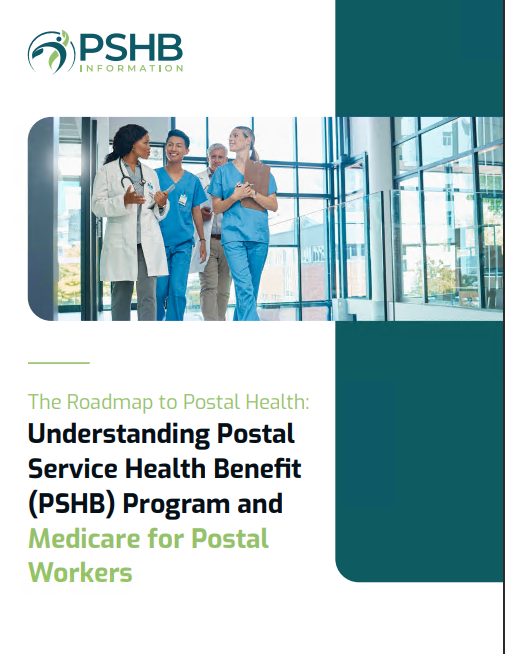Key Takeaways
-
Your Postal Service Health Benefits (PSHB) costs depend on several factors, including your coverage type, Medicare enrollment, and plan selection.
-
Understanding cost-sharing elements like premiums, deductibles, and copayments can help you make informed choices and avoid unnecessary expenses.
What Factors Influence Your PSHB Costs?
When transitioning to the PSHB program, you may notice variations in costs compared to the previous Federal Employees Health Benefits (FEHB) system. These changes are driven by multiple factors, including the government’s contribution, Medicare integration, and plan specifics.
1. Government Contributions
-
The government pays a significant portion of your PSHB premium, similar to FEHB.
-
Your share of the premium depends on whether you choose Self Only, Self Plus One, or Self and Family coverage.
-
The government contribution rate can fluctuate annually, affecting how much you pay out of pocket.
2. Medicare Enrollment
-
If you’re Medicare-eligible and enrolled in Medicare Part B, many PSHB plans offer lower cost-sharing, such as reduced deductibles and copayments.
-
Not enrolling in Medicare Part B when required can lead to higher out-of-pocket expenses and permanent late penalties.
-
Some PSHB plans integrate Medicare benefits seamlessly, helping you save more on healthcare services.
3. Coverage Tier Selection
-
Choosing between basic and high-option plans affects your monthly premiums and out-of-pocket costs.
-
Some plans have higher premiums but lower deductibles, while others have lower premiums with higher cost-sharing.
-
Carefully reviewing the Summary of Benefits and Coverage (SBC) can help you determine which plan aligns with your healthcare needs.
4. Plan Benefits and Extra Services
-
Some PSHB plans offer additional wellness programs, dental, vision, or hearing benefits, which can impact your overall healthcare costs.
-
Plans that include telehealth services or home delivery for prescriptions can help reduce medical expenses over time.
Breaking Down Your PSHB Costs
Understanding your PSHB expenses can help you plan effectively and minimize unnecessary spending.
1. Premiums
-
Your monthly premium varies based on plan selection and government contributions.
-
Annuitants typically pay a different rate than active employees, so it’s essential to check your specific costs.
-
Choosing a plan that aligns with your expected medical needs can prevent you from overpaying.
2. Deductibles
-
A deductible is the amount you must pay before your plan covers certain services.
-
Plans with lower premiums usually have higher deductibles, meaning you’ll need to spend more out-of-pocket before coverage kicks in.
-
If you anticipate high medical expenses, a plan with a lower deductible may be more cost-effective.
3. Copayments and Coinsurance
-
Copayments are fixed amounts you pay for services, such as doctor visits or prescriptions.
-
Coinsurance is a percentage of the cost you pay after meeting your deductible.
-
Medicare enrollees in PSHB plans often see reduced copayments and coinsurance, making medical expenses more predictable.
-
Certain services, such as urgent care or specialist visits, may have higher copayments, so reviewing cost-sharing details is essential.
4. Out-of-Pocket Maximums
-
Each PSHB plan has an annual out-of-pocket maximum, capping your medical expenses for the year.
-
Once you reach this limit, the plan covers 100% of covered services for the remainder of the year.
-
Reviewing your plan’s catastrophic coverage provisions can help you prepare for unexpected medical events.
How Medicare Enrollment Impacts Your PSHB Costs
If you’re retired or close to retirement, understanding how Medicare interacts with PSHB is critical to managing your healthcare costs effectively.
1. Medicare Part A and PSHB
-
Most retirees qualify for premium-free Medicare Part A, covering inpatient hospital care.
-
Enrolling in Part A can reduce your PSHB plan’s hospital-related costs.
-
Some PSHB plans may waive certain inpatient deductibles if you are enrolled in Medicare Part A.
2. Medicare Part B and PSHB
-
If you are Medicare-eligible, enrolling in Medicare Part B can lower PSHB cost-sharing, as your plan will coordinate benefits with Medicare.
-
Failure to enroll in Part B may result in higher out-of-pocket costs.
-
Some PSHB plans offer Medicare Part B reimbursement incentives, reducing the financial burden.
-
Coordinating specialist visits and outpatient services between PSHB and Medicare can optimize your coverage.
3. Medicare Part D and Prescription Coverage
-
PSHB plans include prescription drug coverage, but Medicare-eligible retirees may receive it through a Medicare Part D Employer Group Waiver Plan (EGWP).
-
Enrolling in Medicare Part D separately may not be necessary if your PSHB plan provides drug coverage.
-
Some plans may offer additional prescription savings programs for Medicare enrollees.
Tips to Avoid Overpaying for Your PSHB Coverage
Taking a proactive approach to managing your PSHB plan can help you avoid unnecessary expenses while ensuring you receive the best coverage for your needs.
1. Enroll in Medicare Part B on Time
-
If you’re required to enroll in Medicare Part B, do so during your Initial Enrollment Period (IEP) to avoid penalties and higher costs.
-
Missing your enrollment window could result in late penalties that last for the duration of your coverage.
2. Choose the Right Plan Based on Your Needs
-
Compare different PSHB plans and consider:
-
Premium vs. out-of-pocket costs.
-
Prescription drug coverage.
-
Whether the plan offers Medicare coordination benefits.
-
If a high-deductible health plan (HDHP) with a Health Savings Account (HSA) is a better long-term financial strategy for you.
-
3. Use In-Network Providers
-
Seeing in-network doctors and specialists helps reduce costs, as out-of-network services often have higher copayments and coinsurance.
-
Some PSHB plans may require pre-authorization for certain out-of-network services, which could lead to unexpected costs.
4. Take Advantage of Preventive Services
-
Many preventive screenings and vaccines are covered at no additional cost under Medicare and PSHB plans.
-
Using these services helps detect health issues early, potentially reducing long-term medical expenses.
-
Scheduling annual wellness visits can help ensure your healthcare remains cost-effective.
5. Maximize Medicare and PSHB Coordination
-
If you’re Medicare-eligible, make sure your PSHB plan coordinates with Medicare to lower your share of expenses.
-
Look for plans that waive or reduce deductibles for Medicare enrollees.
Staying Ahead of PSHB Cost Changes
Your healthcare needs and costs may change from year to year, making it essential to review your PSHB plan regularly.
-
PSHB Open Season occurs from November to December each year.
-
Use this period to compare plans, make changes, or switch to a better option.
-
Reviewing your plan’s Annual Notice of Change (ANOC) ensures you’re not caught off guard by unexpected cost increases.
-
Checking provider networks, covered medications, and cost-sharing changes can help avoid future financial surprises.
Managing Your Healthcare Costs Wisely
The right approach to your PSHB plan can make a significant difference in how much you pay for healthcare. Staying informed about Medicare integration, cost-sharing, and annual plan updates ensures you make smart, cost-effective choices.
If you’re unsure about your best options, speaking with a licensed agent listed on this website can help you navigate your healthcare decisions with confidence.








